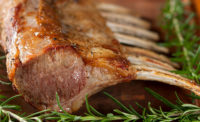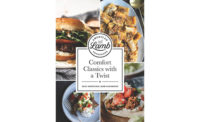State of the Industry 2019 | Lamb
State of the Lamb Industry 2019
Targeting thrill-seekers

Once limited to spring holidays, fine dining and mint jelly, lamb is finding new consumers and fresh approachable paths onto dinner tables and menus.
As consumers, especially Millennials, seek interesting, authentic and adventurous meats, demand for lamb has made inroads.
According to a 2018 consumer use and attitudes study, consumers in the target market (Millennials and those identified as thoughtful eaters) reported an increased interest in buying lamb and a growing number reported they like everything about lamb.
State of the Industry 2019
OverviewBeef (NCBA)
Pork
Chicken
Food Safety
Packaging
Beef (CAB)
Turkey
Veal
Lamb
Animal Welfare
Seafood
Workforce
Watch the 2019 State of the Industry Webinar
Register for free today!
American Lamb Board promotions have focused on making lamb less intimidating, and it appears that these efforts have helped. Target consumers’ intimidation about cooking lamb appeared to be on the decline with just 15 percent saying lamb was too difficult to prepare, compared with 45 percent in 2011 in the recent survey.
IRI/Fresh Look reports lamb sold at retail was up 3 percent in dollar sales in 2018 yet showed a drop of 2.6 percent in pound sales. Leg, shoulder and loin are the leading segments for retail lamb sales. Ground lamb has continued to make gains, now accounting for more than 11 percent of retail sales.
About 62 percent of fine-dining menus feature lamb. Lamb is nearly ubiquitous at Mediterranean cuisine restaurants with 91 percent penetration. Lamb is featured on two-thirds of the entrée menus at steakhouses, other European, mixed ethnicity, French and Italian cuisine restaurants.
While lamb is most often served as an entrée, fine-dining restaurants are menuing lamb outside of the traditional center-of-plate format. Lamb is appearing more in pasta, pizza and appetizers in the form of meatballs, lollipops, sliders, tacos and more unique offerings such as house-made merguez or lamb bacon.
The flavors and ingredients of the Mediterranean continue to heavily influence lamb entrée menus at fine-dining restaurants with ingredients such as yogurt, harissa, olives, fennel, tzatziki, saffron, cumin, aioli, fig, tapenade, tahini and sumac being paired with lamb. Trending flavors associated with lamb fine-dining entrees include curry, horseradish, sugo, paprika, cherry, pistachio, sumac, preserved lemon, fennel, harissa and romesco.
ANNUAL LAMB AND MUTTON FORECASTS
| 2016 | 2017 | 2018 | 2019 | 2020 | |
| Production (million lb.) | 150 | 145 | 153 | 150 | 148 |
| Per capita disappearance (retail lb.)* |
1.0 | 1.1 | 1.1 | 1.1 | 1.1 |
| Lamb and mutton imports (million lb.) |
216 | 252 | 273 | 270 | 269 |
Forecasts are in bold. * Per capita meat disappearance data are calculated using the Resident Population Plus Armed Forces Overseas series from the Census Bureau of the Department of Commerce. All data as of Aug. 15, 2019. Source: World Agricultural Supply and Demand Estimates and Supporting Materials. For further information, contact: Mildred M. Haley, mhaley@ers.usda.gov<
While lamb is most often associated with fine dining, Datassential Menu Trends reports lamb is more common on menus today than 10 years ago across all segments. Lamb penetration is at 16.3 percent on these menus, up 14 percent in the last 10 years (2018 versus 2008). Lamb has a strong menu presence among Indian, Mediterranean and African cuisine.
More than one half of lamb sold in the United States is imported; however, as consumers are more interested in where their food comes from, they are supporting local lamb tracked back to the sheep farm or ranch.
According to use and attitudes research done by the American Lamb Board, about 68 percent of respondents in 2018 indicate a preference for lamb raised in the United States, up from 40 percent in 2011.
Not surprisingly, the Datassential Menu Trends report shows domestic lamb is called out more than 3 to 1 over imported lamb on fine-dining menus. NP
Looking for a reprint of this article?
From high-res PDFs to custom plaques, order your copy today!





